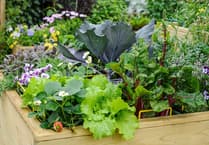YOU must have noticed that just when we want our gardens to look their best - in high and late summer, with a glorious show of colour to impress friends and neighbours - nature has the habit of deciding to take time off.
Spring and early summer flowers have faded, the first flush of roses is over, the glories of magnolias, forsythia, lupins, wisteria and flowering cherries are but a memory and things are starting to look decidedly dull along the perennial flower borders.
Our increasingly eccentric climate, with its unseasonal cold, heat, drought and heavy rain, certainly doesn’t help, but the good news is that if you start planning now there’s no reason why in future you shouldn’t keep your garden in full bloom until the first frosts of winter.
There’s now a huge range of late-flowering perennials and shrubs which are at their peak when summer turns to autumn, including sedums, asters (Michaelmas daisies), dahlias, fuchsias and Japanese anemones.
Some of these can be bought now as container plants to give lack-lustre borders and containers an instant colour boost while you work out a longer term plan.
Late-flowering plants will not only keep your garden colourful and interesting, but will also provide insects with nectar and pollen they wouldn’t otherwise have, which is a pretty important bonus.
Ironically, it’s often our weakness for buying plants that are already in flower, which causes the problem in the first place. It’s been dubbed the “impulsive spring flower syndrome”. After a dreary winter, who can blame us for choosing plants that are in flower but which will lose their blooms by September?
So what are the best late bloomers which will keep your garden looking a picture as the nights draw in? Among my favourites are salvias, which keep the garden alive with their vibrant colour long after other flowers have faded.
Most are tough and hardy, come back year after year, are easy to grow and a sure-fire target for bees. They are either shrubs, like salvia microphylla or herbaceous like salvia nemrosa. Deadhead them and they should flower well into autumn.
.jpg?width=752&height=500&crop=752:500)
Most dahlias will keep on flowering until the first frosts to provide welcome late colour and so will winter-flowering violas. The popular Black-Eyed Susan, with its cheery yellow daisy-like flowers, and asters with their purple flowers, will fill your garden until well after October with a bit of luck.
Increasing-popular late bloomers are Japanese anemones, with elegant flowers in pink or white. They will tolerate life in the shade but much prefer a sunny situation.
Hellebores are tough beauties producing saucer-shaped elegant nodding blooms in shades of green, white, pink or ruby. These perennials have a long flowering period from autumn and winter well into spring. Mainly evergreen with handsome leaves, they thrive best in shadier spots.
Antirrhinums are long-flowering annuals, providing flowers into late autumn and available in a huge range of colours. Dead-heading will keep them flowering.
Fuchsias are hard to beat for bright splashes of colour in containers and borders and in our part of the world have been known to keep flowering until the arrival of really hard frosts
Chrysanthemums are traditional autumn flowers and come in a wide variety to colours from red and yellow to orange and white. They do best in a sheltered spot and will reward you with flowers almost up to Christmas.
Flag lilies, nerines, red hot pokers, penstemons, phlox, ceanothus, verbena…the list of plants happy to keep your garden bright with colour until the beginning of winter is almost endless. And the hebe Autumn Glory, with its vibrant blue/purple flowers loved by pollinating insects, says it all.
Then of course, there are plants which will keep flowering throughout the winter like specially-bred pansies, and cyclamen, mahonia, daphne, winter honeysuckle and winter aconites. All will put on a brave show to help brighten those short dark days and convince us that spring really isn’t far behind.
.jpg?width=752&height=500&crop=752:500)
JUST THE JOB
What to do in West Somerset gardens in August
August is supposed to be a quiet month but in fact it can be pretty busy, with pruning, harvesting and taking that last chance to sow and plant out next spring’s crops.
IN THE FLOWER GARDEN
Prune climbing and rambling roses once they’ve finished flowering - unless they’re repeat flowerers.
Dead-head bedding plants and perennials to encourage them to flower into the autumn and cut back faded perennials to keep borders tidy.
Prune all summer-flowering shrubs once blooms are finished and trim lavender plants once they have finished flowering, by up to a third.
Keep patio container plants well watered and fed with liquid fertiliser every fortnight.
Wisteria will benefit from having laterals pruned back to a couple of buds.
IN THE VEGETABLE GARDEN
Lift maincrop onions when the foliage has yellowed and leave them out for a few days before bringing in to dry off.
Feed high-potash fertiliser such as tomato food, not only to tomatoes but to sweetcorn, pepper, cucumber and aubergine plants once fruit starts to form.
Start harvesting maincrop potatoes when leaves go yellow and die back. Store in hessian sacks which keep out the light but allow ventilation.
Keep picking courgettes and runner beans or further flowering or fruiting will be inhibited. Garlic should also be ready for lifting now.
Spring-sown carrots and beetroots should be ready to harvest but can be left in the ground for a while longer.
When soil is moist, sow spring cabbage and winter lettuce. Mulch with compost as soon as seedlings are large enough.
PEST CONTROL
Beware a second wave of cabbage white caterpillars on brasssicae and red spiders in the greenhouse. Daily spraying with warm water is said to be a deterrent.
Watch for the flea beetle on young radishes and spring cabbage. The traditional remedy was to beat along the rows with a handful of leafy elder twigs which is perhaps worth a try when no-one’s watching!
Wasps will be a nuisance among ripening fruit so try hanging half-full jars of jam-sweetened water among the branches.
.jpg?width=455)




Comments
This article has no comments yet. Be the first to leave a comment.